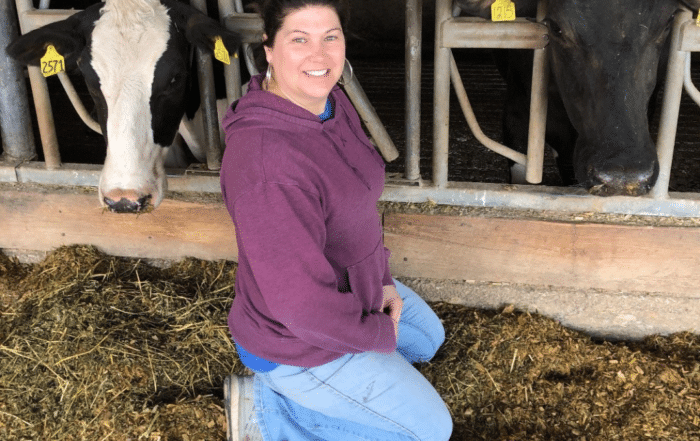The Food Safety Dish on Dairy
While food safety techniques for your favorite dairy foods may seem obvious, they are not always so straightforward. Here are answers to those occasionally tricky questions about keeping nutritious and wholesome milk, cheese, and yogurt safe and delicious for your family to eat or drink.
Properly storing perishable foods like dairy products is usually no problem when your refrigerator/freezer is working as it should. However, problems affecting not only the quality of your food but the safety of it as well occur when the temperature inside the unit rises above safe or acceptable levels when the power goes out.
Keeping Dairy Foods Safe is important – so here are some helpful tips to keep food safe.
- Eliminate guesswork. Keep an appliance thermometer in the refrigerator and freezer at all times. Temperature is vital information to know during a power outage.
- When the power goes out, keep refrigerator and freezer doors closed – open only as necessary.
- Refrigerated items should be safe for up to four hours—if the temperature inside has been maintained at 40°F (or lower).
- Most perishable foods that have been above 40°F for two hours or more should be thrown out.
- A full freezer will stay at a safe temperature for about two days; a half-full freezer for about one day.
- Some foods that have partially thawed may be safely refrozen if they contain ice crystals; however, all foods need to be evaluated separately to determine safety.
- When in doubt, throw it out.
When it comes to dairy, the following are considered safe even if held above 40°F for more than two hours:
- Hard cheeses: Cheddar, Colby, Swiss, Parmesan, provolone, Romano
- Processed cheeses
- Grated Parmesan, Romano or combination (in can or jar)
- Butter
Dairy Foods That Have Been Frozen
How Cold is Cold Enough?
Dairy foods are perishable and should always be kept cold. Doing so not only ensures flavor but also keeps them safe to eat. After grocery shopping, unpack and store dairy products first, placing milk in the back of the refrigerator, which tends to be the coldest place. Remember to return the milk to the fridge immediately after pouring, too.
Additionally, make sure the refrigerator temperature is set to 40 degrees F or lower. When food is stored in the “danger zone”—temperatures from 40 to 140 degrees F—the number of harmful bacteria can double in as little as 20 minutes.
When the Power Goes Out
There’s never a good time for a power outage—but it feels especially dire when you have a fridge full of food. If the inside temperature of the refrigerator has been consistently maintained at 40 degrees F prior to the outage, the food should remain safe to eat for up to four hours. When temps creep above 40 degrees F for two hours or more, most dairy foods, like milk, yogurt, and cottage cheese, should be discarded.
Hard cheeses like cheddar, Colby, Swiss, and provolone; processed cheeses; grated Parmesan cheese in a container; and butter are considered safe even if they are held above 40 degrees F for more than two hours. However, use discretion and discard these types of cheeses if they have an “off” aroma or appearance.
To Freeze or Not to Freeze?
If you find yourself with an excess of milk or cheese in the refrigerator, you may consider freezing it. While both milk and cheese will remain safe to eat when frozen, the taste and consistency of milk changes, and cheese often becomes crumbly when thawed. If you try it, label the containers with the date. You can freeze milk for up to three months and shredded/hard cheeses for up to six months.
On the other hand, yogurt can be frozen for up to two months without a change in taste and texture. This can be a money-saving trick, allowing you to stock up when your favorite yogurt is on sale. It can also reduce food waste if you are unable to use yogurt by the date on the package. Here are some useful dairy freezing tips.
Here is a handy chart to help you determine which dairy foods to keep from your freezer and which ones to toss once power is restored. (Remember: Never taste food to determine its safety.)
Milk
Still contains ice crystals and feels cold as if refrigerated?
Refreeze. May loose some texture.
Thawed, and held above 40°F for more than two hours?
Discard
Ice Cream, Frozen Yogurt
Still contains ice crystals and feels cold as if refrigerated?
Discard
Thawed, and held above 40°F for more than two hours?
Discard
Cheeses (soft and semi-soft)
Still contains ice crystals and feels cold as if refrigerated?
Refreeze. May loose some texture.
Thawed, and held above 40°F for more than two hours?
Discard
Cheeses (hard)
Still contains ice crystals and feels cold as if refrigerated?
Refreeze
Thawed, and held above 40°F for more than two hours?
Refreeze
Cheeses (shredded)
Still contains ice crystals and feels cold as if refrigerated?
Refreeze
Thawed, and held above 40°F for more than two hours?
Discard
Casseroles containing milk, cream, eggs, soft cheeses
Still contains ice crystals and feels cold as if refrigerated?
Refreeze
Thawed, and held above 40°F for more than two hours?
Discard
Cheesecake
Still contains ice crystals and feels cold as if refrigerated?
Refreeze
Thawed, and held above 40°F for more than two hours?
Discard
Food safety should always be a top concern when buying, handling, cooking and storing foods. Being informed about general storage guidelines, as well as how to protect foods during a power outage, will help preserve the quality and safety of the foods you serve your family.
Storage Guidelines to Maintain Quality, Freshness and Safety
Proper storage and handling of food products is a necessity that will help maintain the quality, freshness and safety of the items you purchase and provide for your family.
Dairy foods are perishable and should always be kept cold. Here are some general guidelines for storage from date of purchase.
Butter
Refrigerator (at or below 40ºF)
1-2 months
Freezer (at or below 0ºF)
6 – 9 months
Cheese, hard (ex. Swiss or cheddar)
Refrigerator (at or below 40ºF)
6 months, or 3 – 4 weeks if refrigerated after opening
Freezer (at or below 0ºF)
6 months
Cheese, soft (ex. brie)
Refrigerator (at or below 40ºF)
1 – 2 weeks
Freezer (at or below 0ºF)
6 months
Cheese, shredded (ex. cheddar, mozzarella)
Refrigerator (at or below 40ºF)
1 month
Freezer (at or below 0ºF)
3 – 4 months
Cheese, processed slices
Refrigerator (at or below 40ºF)
3 – 4 weeks
Freezer (at or below 0ºF)
Not recommended
Cottage cheese, ricotta
Refrigerator (at or below 40ºF)
2 weeks, or 1 week if refrigerated after opening
Freezer (at or below 0ºF)
Not recommended
Cream cheese
Refrigerator (at or below 40ºF)
2 weeks
Freezer (at or below 0ºF)
Not recommended
Cream, heavy
Refrigerator (at or below 40ºF)
10 Days
Freezer (at or below 0ºF)
3 – 4 months
Kefir, fermented milk
Refrigerator (at or below 40ºF)
1 week, or 1-2 days if refrigerated after opening
Freezer (at or below 0ºF)
Not recommended
Milk, plain or flavored
Refrigerator (at or below 40ºF)
Package use-by date
Freezer (at or below 0ºF)
3 months
Milk, lactose-free
Refrigerator (at or below 40ºF)
1 week
Freezer (at or below 0ºF)
Not recommended
Sour cream
Refrigerator (at or below 40ºF)
Package use-by date
Freezer (at or below 0ºF)
Not recommended
Yogurt
Refrigerator (at or below 40ºF)
1 – 2 weeks
Freezer (at or below 0ºF)
1-2 months
Half & Half
Refrigerator (at or below 40ºF)
3-4 days
Freezer (at or below 0ºF)
4 months
Source: U.S. Department of Agriculture FoodKeeper App
Because of the way it is processed, shelf-stable (UHT – ultra high temperature) milk can be stored at room temperature; however, once opened, it must be refrigerated.
Decoding Dates
The phrases and dates on food packaging can be confusing. But they deliver information that’s useful when you’re grocery shopping and when you’re deciding whether to keep or toss perishable foods. Here are the most common phrases seen on food packages, and how they are defined by the USDA.
Sell By
Provides guidance to the store about how long to display the product for sale. While this date allows for a reasonable amount of time for you to use the food at home, you should buy the product before this date passes.
Best If Used By (or Before)
Recommended for best flavor or quality. It is not a purchase or safety date.
Use By
The last date recommended for the use of the product while at peak quality; determined by the manufacturer.
Always choose the latest dates available on the shelf to give yourself enough time to use the product at its peak of quality and safety. If you’re not sure that the dairy product is safe to eat, it’s best to discard it.
Is Raw Milk OK to Drink?
Pasteurization is the process of heating raw milk to at least 161 degrees F for 15 seconds to remove milk-borne pathogens. This simple process destroys harmful bacteria while maintaining milk’s quality, taste, and nutritional value. While some people tout raw milk as a better choice, it’s not recommended from a safety standpoint, especially for infants and young children, older adults, pregnant women, and people with a weakened immune system. In fact, healthy people of any age can become very sick if they consume raw milk that contains bacteria.
What about Food Safety on the Farm?
Many steps go into ensuring that the milk and dairy foods you love deliver the flavor, texture, and unique nutrition profile you expect. From cow care to the use of sterilized equipment to hold and efficiently transport fresh milk, to numerous food safety, quality, and sanitation checks along the way, milk and dairy foods are among the most highly regulated foods in the supermarket.
Once you bring them home, it’s your job to exercise proper storage and handling practices to prevent food waste, an unpleasant eating experience, or even sickness.






